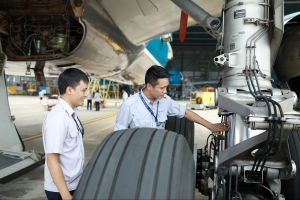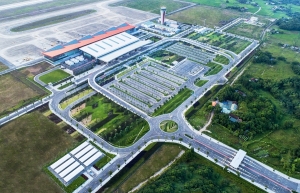Reforming the aviation sector
On October 11, at VIR's headquarters in Hanoi, a roundtable "Small airports for local economy take-off" was held, with the participation of representatives from the National Assembly Economic Committee, the Ministry of Planning and Investment, Lao Cai People's Committee, localities, and businesses.
 |
| The event tackled issues surrounding the development of local airports. Photo: Dung Minh |
According to Michel Werson, chief economist of NACO, an airport design and planning business in the Netherlands, "There is danger in judging too fast, only based on proximity."
The NACO speaker pointed out the inaccuracy of evaluating airport settings based on distance alone, citing worldwide standards.
In the United States, two airports in Wisconsin are proposed to be separated by just 48km (40 minutes of driving). Each airport has fewer than one million yearly passengers, and due to Wisconsin's severe winter conditions, the state is not a favoured tourist destination, resulting in inadequate traffic for these airports to operate financially.
Werson said that designing a single airport was sufficient in this instance.
However, also in the US, in South Carolina, the two airports are separated by 99km, but each airport has its own passenger volume, between 1.6 and 2.6 million passengers per year, since this region possesses a larger thriving economy, is home to prestigious universities, and has numerous popular attractions.
"Internationalisation demonstrates that merely evaluating the distance between airports when planning and analysing feasibility is an oversimplification; several other local elements must be carefully evaluated on a case-by-case scenario," Werson added.
 |
Moreover, according to a spokesperson of NACO, the private sector's involvement in the construction of local airports would provide numerous benefits since these organisations have the money and managerial skills to optimise income and profit.
Werson explained, using Cyprus as an example, that the Cypriot public decided that Hermes Airports, a private company that now manages and operates two airports on the island, should be selected when licencing two airports there.
Through this public-private cooperation, Hermes Airports have invested 640 million euros, plus an extra 500 million euros in franchise fees, generating 20,000 direct and indirect jobs and contributing 12 per cent to the region's gross domestic product.
Dr. Tran Dinh Thien, former director of the Vietnam Institute of Economics said, “Private sector participation is required to tackle the country's most pressing concerns. To better handle the integration challenge, the government must have faith and engage the private sector in improving the structure and to collaborate with them. For big benefits at the national level, planning requires the private sector's viewpoint, particularly that of giant companies with the resources to observe beyond.”
Various approaches can involve the private sector: privatising large airports and using the proceeds to sustain and invest in the smaller airports, bundling multiple small airports, and creating bundles or clusters that combine one or more larger airports with multiple small airports, probably the most common form.
Nevertheless, if opting for the third path, the NACO expert said that it was crucial to specify the investment needs of small airports. Otherwise, private firms may be tempted to neglect the development of smaller airports in favour of those with greater benefits.
With key airports in Vietnam becoming increasingly congested and airports in border provinces, particularly in remote regions, constantly struggling as demand for transportation rises in the aftermath of the pandemic, investment in aviation infrastructure planning and development becomes heavily concentrated.
In addition, the modernisation of aviation infrastructure will boost the local economy by facilitating manufacturing, import and export, and timely search and rescue.
The International Air Transport Association predicts that by 2035, Vietnamese airlines will serve up to 136 million passengers, double the 70-80 million passengers predicted for 2022.
| Phan Duc Hieu - Standing member, National Assembly Economic Committee
The national master plan is a macro problem. Currently, there are criteria for airport construction planning. I recommend that there be more transparent criteria in verifying priority so that localities will not be upset when they are not approved. In addition, the planning also needs to be approved soon so that the localities can go forward with implementation. Nguyen Trong Hai - Vice Chairman, Lao Cai People’s Committee
The province also prepares transport infrastructure connections from the expressway to the airport and from the airport to the development centres of the province such as Sapa, Y Ty, Bac Ha, and the border gate area of Lao Cai city, creating favourable conditions to attract investors. We will also carry out planning along the Red River. Around the airport will be urban areas and logistics services, creating momentum for development. In addition, we have also issued bidding documents to select suitable investors. Nguyen Van Vinh - Deputy director, Vietnam Institute for Development Strategies, Ministry of Planning and Investment
To invest effectively in the airport, it is necessary to have a combination of the state and the private sector to calculate the timeline and scale of the projects jointly. It is also needed to evaluate every aspect carefully to avoid wasting natural and power resources while simultaneously clarifying the concept of the small airport. Nguyen Dinh Cung - Former director, Central Institute for Economic Management
The need for localities to develop connections, including airport connections, is a legitimate need, and in many cases, helps localities to exploit their potential and advantages efficiently, which can create prosperity in the medium term. As with Lao Cai, Ha Giang, Quang Tri and some other localities, it is clear that to aid these localities to make the best use of their advantages, connectivity is indispensable, in which the connection by aviation can be said to be the most feasible and most effective, while the investment may be the least compared to road investments. Dr. Tran Dinh Thien - Former director, Vietnam Institute of Economics
Freeways contribute to improved local connectivity, whilst airports add to the region's accessibility. Localities are only required to set up small airports, but they must link worldwide, not simply between internal states. The presently inefficient airports should be eliminated while expanding the construction of new airports; collaborating with the private sector; expanding globally, and promote economic development. Michel Werson - Chief economist of NACO
When we look in terms of throughput, a big majority of no less than 78 per cent of commercial airports handle less than one million passengers per year. Together these airports handle only 5 per cent of global traffic. The rationale is that when small airports benefit from a network, it gives access to capital and makes it possible to keep facilities up to date, which helps to create a quality product and, in turn, attracts and retains airlines. |
 | Investors to be selected for components of Long Thanh International Airport The Civil Aviation Authority of Vietnam (CAAV) is now selecting investors for maintenance workshops and ground-handling services, which is a part of subproject four of Long Thanh International Airport. |
 | Action required for aviation to achieve net-zero commitments Fleet renewal, improved operational efficiency, renewable energy, and advanced technology are the four main actions that need to be taken by the commercial aviation industry between now and 2050 |
 | Linking the skies with upgraded aviation infrastructure Several nations have devoted generations to constructing sophisticated aviation infrastructure as an economic launchpad. In Vietnam, plans are in the making to follow suit and upgrade the nation's airport infrastructure to serve the ever-increasing demand. |
 | More airports in need to aid aviation sector's growth prospects Building more airports proves important to keep abreast with the aviation sector’s upbeat growth prospects. |
What the stars mean:
★ Poor ★ ★ Promising ★★★ Good ★★★★ Very good ★★★★★ Exceptional
Related Contents
Latest News
More News
- Vietnam GDP posts second-strongest growth since 2011 (January 06, 2026 | 08:35)
- Cake by VPBank posts strong gains in scale and efficiency leveraging AI focus (January 05, 2026 | 18:55)
- Vietnam's retail market tops $269 billion in 2025 amid e-commerce boom (December 31, 2025 | 19:00)
- Global alliance develops $1 billion AI data centre network in Vietnam (December 30, 2025 | 10:08)
- Businesses ramp up production as year-end orders surge (December 30, 2025 | 10:05)
- Vietnam’s GDP forecast to grow by 9 per cent in 2026 (December 29, 2025 | 08:29)
- Vietnam's top 500 value-creating enterprises announced (December 27, 2025 | 08:00)
- Three-way partnership unveiled to ease financing at Hong Hac City (December 24, 2025 | 14:13)
- PM orders investment model for North–South high-speed rail (December 22, 2025 | 17:43)
- First members of Danang International Finance Centre revealed (December 22, 2025 | 17:39)







 Tag:
Tag:




















 Mobile Version
Mobile Version